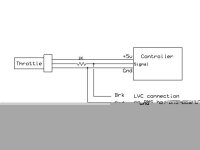dumbass said:
My question to you is this; your graph indicates a LV condition on several ocations. And you say that it only limited your max speed. But it has always been my understanding ( and no one here has ever indicted it was wrong) the if a low voltage accured it BMS would shutdown the pack discharge. This is not the same as limiting your speed. Are you saying that after the BMS shutdown you reset it and continued on at a reduced speed because of the LV condition? Or did the BMS actually limit your max speed automaticly? To me LVC means "low voltage cutoff" not "low voltage control" But If a BMS only linits your current draw it is a different situation and i would like to hear more and where you bought this BMS.
How the operator 'feels' the LVC event depends on the type of LVC signal and how it's used. For example - in the E-S/Goodrum/Fechter BMS, the low voltage event 'detection and reporting system' is based on a voltage detector that signals when a cell hits the low point. The 2.1V detector will signal as voltage drops down thru 2.1V, and will release it's signal when voltage rises above 2.2V. There's no latching at all, just the .1V difference between 'signal on' and 'signal off'. Since nothing latches off, there's nothing to reset. Protection is automatic, repeatable, and much faster than one can respond to a LED or a buzzer.
Let's use the low voltage signal to do something.
One method is to connect it to the controller's brake inhibit line - just like another brake lever.
View attachment LVC_Brake.jpg
When a cell drops thru 2.1V, the BMS essentially closes a brake switch. This tells the controller to cut power to the motor. Once there's no load on the pack, cell voltage recovers. Once the low cell voltage springs back up thru 2.2V, the virtual brake handle is released and power is restored. If the throttle is left open thru multiple low voltage events, the rider will feel about 1-4 pulses per second depending on how quickly the cell voltage recovers.
Another method is to use the low voltage signal to operate a relay or contactor or MOSFET switch that cuts power from the pack. One of Gary Goodrum's LVC boards has such an active power disconnect function. Same scenario here as well - cell drops low, active shut-off opens the wire to the controller, cell voltage recovers, power is restored. I don't know how quickly the pulses will happen here - I haven't ridden this type of disconnect.
The method I'm trying on my bike - and the method that was in use when I collected the charted data - is a throttle pull-down. The circuit is listed in one of the BMS threads.

From looking at the circuit, I expected that a low voltage event would abruptly cut the throttle and result in feeling 'power pulses'. But with my hall-effect throttle there's no jerking at all - just what seems to be a reduction in how much current I can draw. With no LVC connected, I can twist the throttle and pull 100A regardless of the status of the pack. With the LVC signal connected to the throttle, I was limited to about 73A max as a cell bounced around the 2.7V set point. It was very smooth and was undetectable on the road except that it seemd my top speed was down a bit and that acceleration dropped off a bit faster than normal. I didn't realize I had bounced off LVC until I looked at the data after the ride.
I hope that helps some,
Andy



